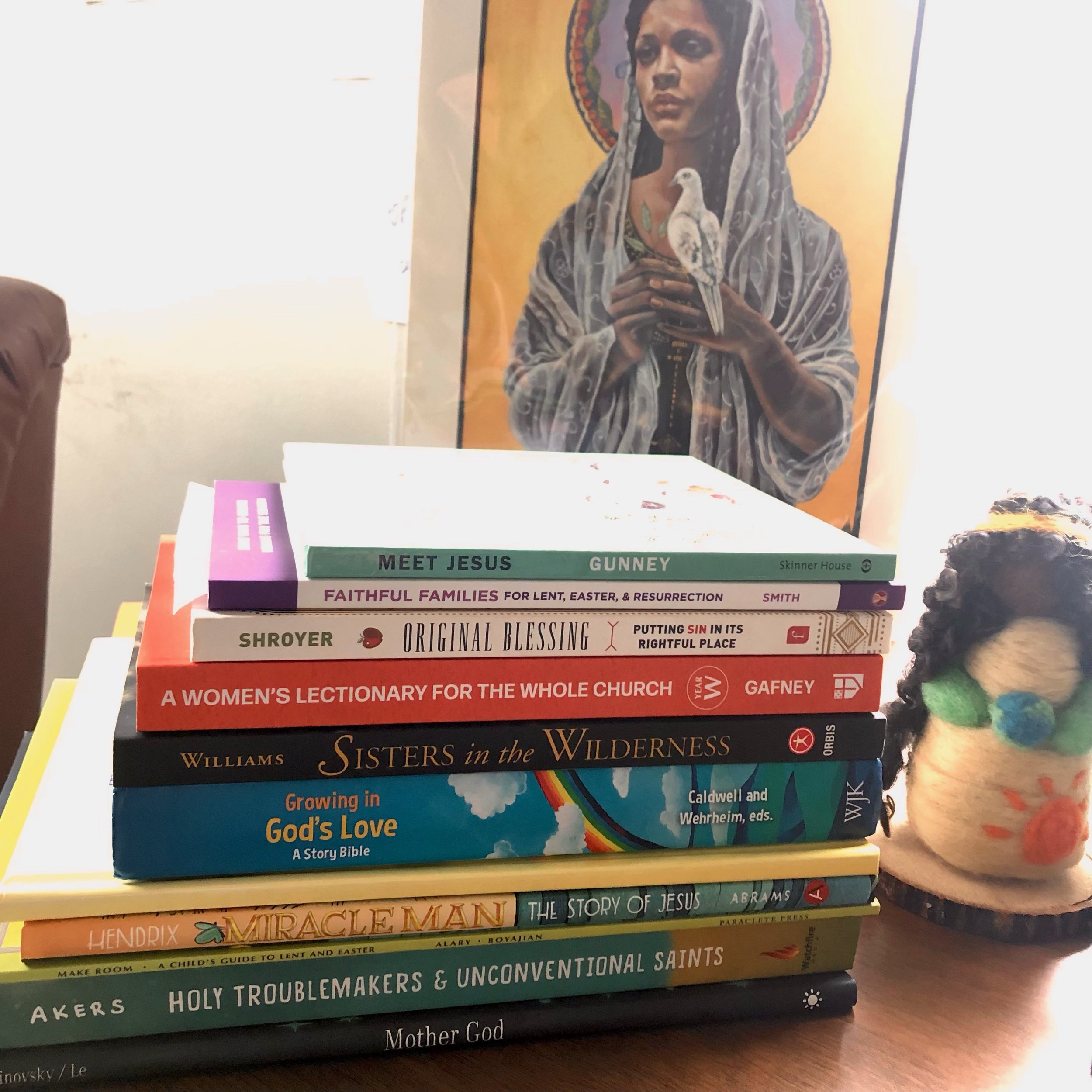What if Jesus came to live, not to die?
By Daneen Akers
How might we view story of Jesus differently if we taught that he came to show us how to live, instead of coming to die? Dismantling substitutionary atonement is holy troublemaking work indeed.
Early on in my faith shift (before I realized just how many atonement theories there are), I had a heck of a time figuring out how to talk about Easter with my daughter. I remember vividly the first time she asked me what Easter was about. We were walking our dog on a sidewalk in San Francisco where we lived then. She was three and on my back in a carrier. We were admiring the spring flowers when she asks me what Easter is about.
I freeze a little bit. What am I going to say? I’d stopped believing in a substitutionary atonement model, but I hadn’t quite figured out what other options I had.
I knew I didn’t believe that a loving Divine required the sacrifice of an innocent, and yet that thread is so thoroughly interwoven through almost everything that Western Christianity and even secular Western culture touches, that I felt lost with where to even start unraveling.
“Um, well, it’s about spring and new life—and chocolate bunnies!” That’s pretty much what I went with for a few years as a punt because I didn’t have anything else to offer that I felt in alignment with. (And, truthfully, I think that’s a lot less harmful than indoctrinating young children that Jesus had to die because of their sins, so even if that’s where I’d landed, I’d be okay with that today.)
One day I heard a liberation theology teacher explain several of the dominant atonement theories—suddenly I felt a door crack open and light stream in just realizing there were (and had always been) multiple perspectives about Jesus’s death. Maybe God was just as horrified as I was that our most dominant story teaches that violence is required, even redemptive. Maybe it’s Jesus’s teachings that save, not his death?
I now see Jesus’s death as Herb Montgomery, one of the modern-day holy troublemakers, does:
Jesus’s death was an interruption in his ministry, not the point of it. His message of love-your-enemies, the last-shall-be-first, and God’s-realm-is-for-all was deeply threatening to the status quo. So, he was executed by the state as a cautionary tale for those who would follow his teachings.
This is why Jesus died: His teachings upset powerful hierarchies and status quos, so he was executed by the state. The good news is that death and violence didn’t have the last word. It’s a love-ultimately-wins story.
And that lens on Jesus’s story is good news indeed, especially as we are reminded again by current world news of how violence can often seem to be the best choice. Peacemaking through nonviolent means is a harder path that runs counterculture to almost every dominant narrative our culture tells.
Resources to help share a view of Easter beyond substitutionary atonement.
Resources to help dismantle substitutionary atonement
Last month as part of the launch of her new book, Faithful Families for Lent, Easter, and Resurrection, Pastor Traci Smith facilitated a conversation with myself and Herb Montgomery about understanding and sharing a theology of the cross that’s beyond substitutionary atonement. We did a similar conversation last year on Instagram Live, but this is a much easier format for me to follow. It’s now up on her YouTube channel here. It's a topic we're all quite passionate about, and your feedback is really welcome about where you might need more support as you work to dismantle substitutionary atonement at home and elsewhere.
Books and more books (pictured above)
Some of the books Herb, Traci, and I recommended in that conversation as further reading are these:
Meet Jesus by Lynn Tuttle Gunney: a Unitarian resource book that tells the story as a historical account.
Faithful Families for Lent, Easter, and Resurrection by Rev. Traci Smith: The fourth book in this series and full of very simple, practical ideas for creating meaningful rituals for this season at home.
Original Blessing by Danielle Shroyer: phenomenal book helping to explain how the doctrine of original sin came about centuries after the life of Jesus, how harmful it is, and how we can join our other siblings in faith with the same stories who did not come up with original sin and how we can come to a view of original goodness instead.
A Woman's Lectionary for the Whole Church by Dr. Wil Gafney: A must-read new lectionary by a womanist scholar, priest, and professor who is the prophetic voice we need right now on so many topics, including this one.
Sisters in the Wilderness by Delores Williams: A foundational womanist text that helps explain why the myth of redemptive violence is so damaging, especially to those already marginalized.
Growing in God’s Love: A Storybook Bible edited by Elizabeth Caldwell: a wonderful new story Bible with no substitutionary atonement and gender-neutral pronouns throughout for God with the Easter narrative told simply and in an age-appropriate way (with an emphasis on the women who did not abandon Jesus).
This is the Mystery of Easter by Amelia Dress Richardson: a super simple book for littles about the story of Jesus without substitutionary atonement.
Miracle Man by John Hendrix: incredible visuals with Jesus’s death handled very simply and age-appropriately)
Make Room: A Child’s Guide to Lent & Easter by Laura Alary: A simple approach to this season to help young children get a big picture context of this liturgical season (also highly recommend her story Bible for slightly older children, Read, Wonder, Listen, also gender-neutral pronouns for God, and also with Jesus’s death handled very well with the women who stayed with him centered).
Holy Troublemakers & Unconventional Saints by Daneen Akers: profiles and original art of people of diverse spiritual and faith backgrounds who have worked for more love and justice aimed at middle grades (Herb Montgomery, Bayard Rustin, and Cindy Wang Brandt’s profiles, in particular, bring up nonviolence and original goodness vs original sin worldviews).
Mother God by Teresa Kim Pecinovsky: gorgeous new picture book introducing children to God our Mother (really helpful to dismantle substitutionary atonement with a mothering God view)
Note: The artwork in the back of that pic of these wonderful books is Sophia God with a Dove by Sue Ellen Parkinson, and the felted Mama God was made by my older daughter, the same daughter whose question about Easter 10 years ago caused me to panic. I wish I could have told my new mom, deconstructing self that it was all going to be okay...in a decade, she'd be making me cry good tears with presents like a felted Black Mother God holding the whole world in her hands. (For anyone early in your dismantling of fundamentalism and panicking about parenting through it, I see you. And it will be more than okay in time.)
Cosmic Mother/Creation by Sergio Valasquez
God our Mother helps us move beyond substitutionary atonement
Mama God (She Who Is, Womb of Life, Sustaining Mother) doesn't require her children to suffer or an innocent to die, which is another reason why I'm been on a soapbox lately about the deep necessity of feminine God-language and metaphors. Here's the deeper dive blog I wrote about why we must have God in feminine form.
May Mama God energy encircle you and yours this Easter as we step into a story that teaches that love ultimately is the most powerful force in the universe.
Daneen Akers is the author of Holy Troublemakers & Unconventional Saints, an illustrated children’s storybook about people of diverse faiths who rocked the religious boat on behalf of love and justice.



